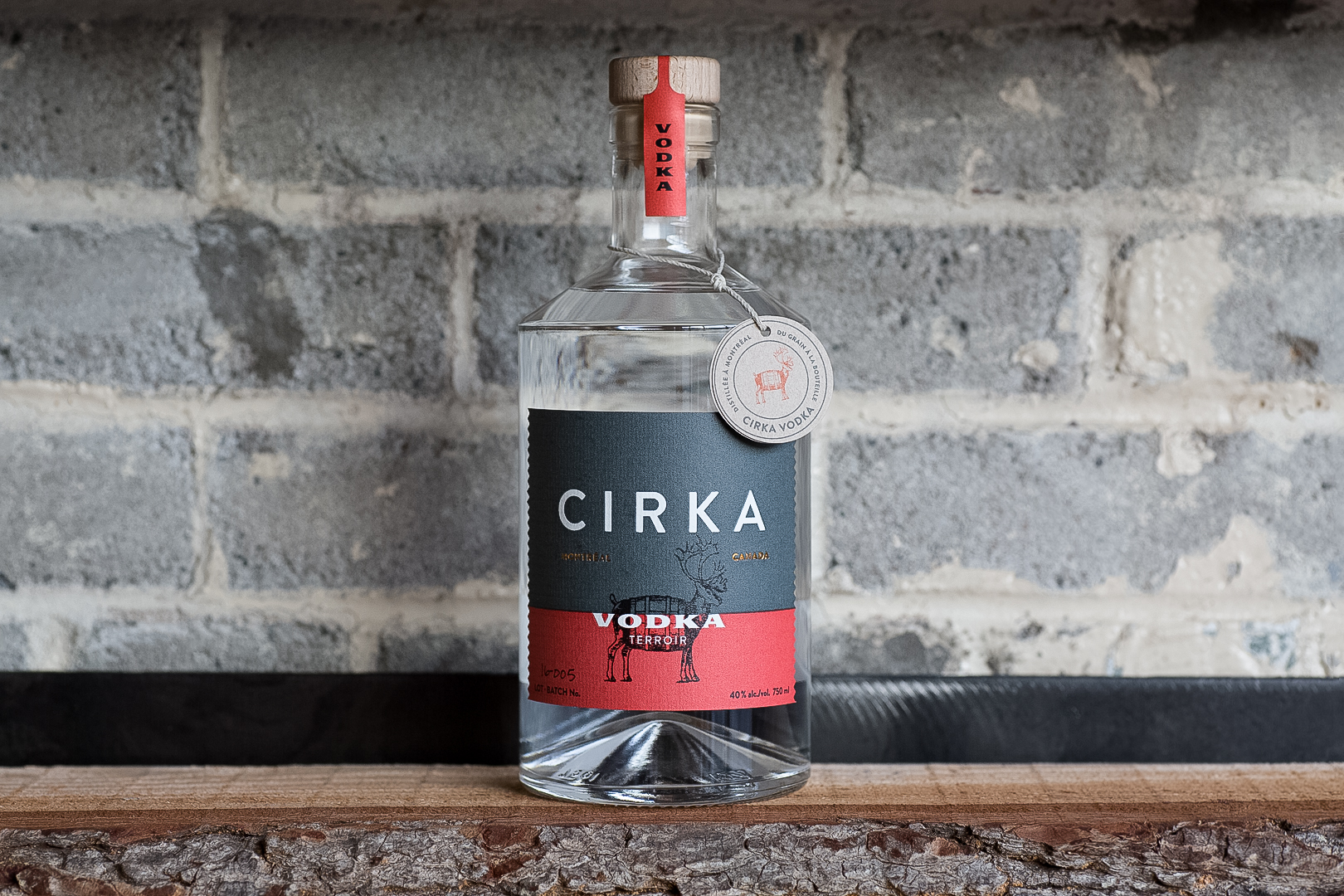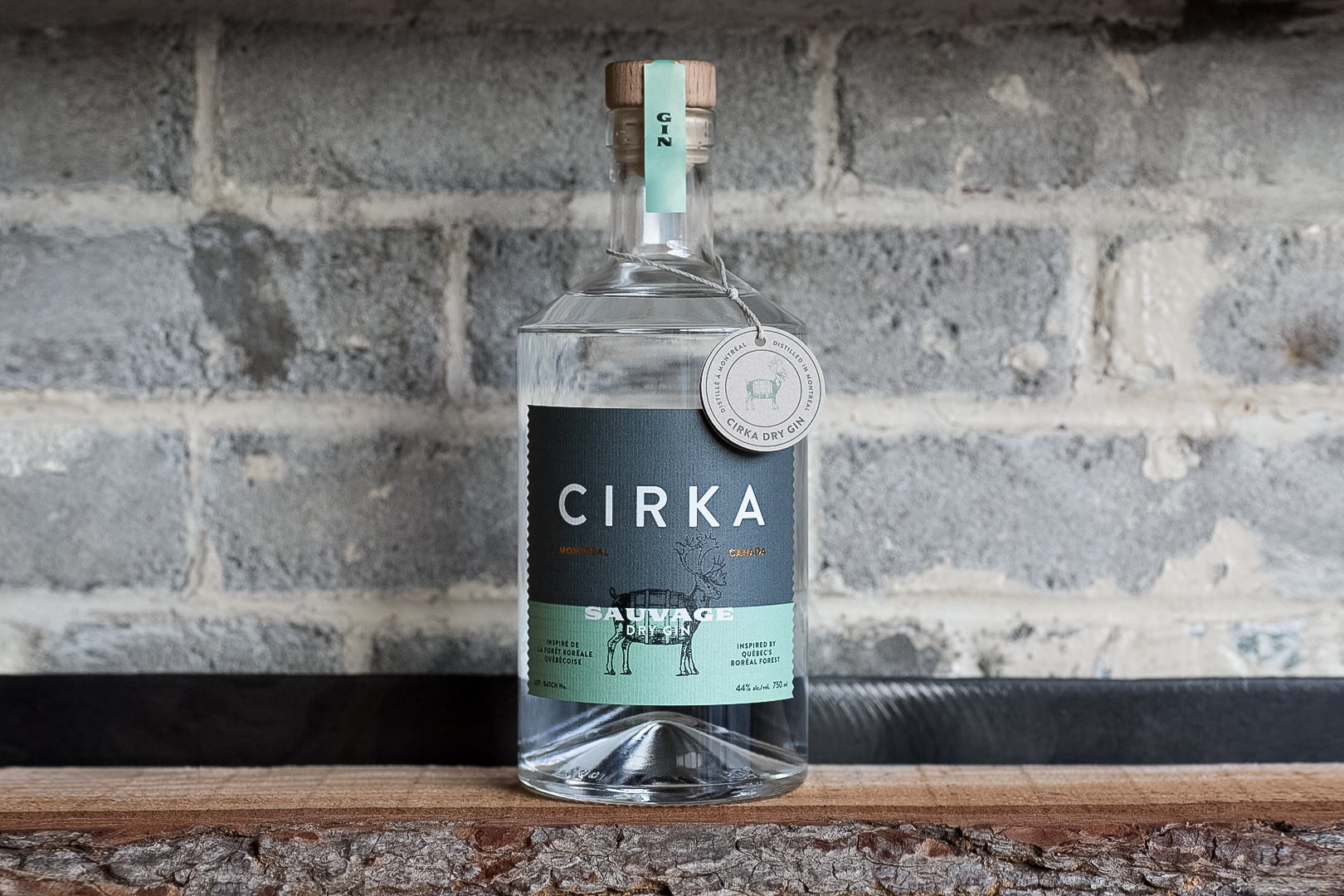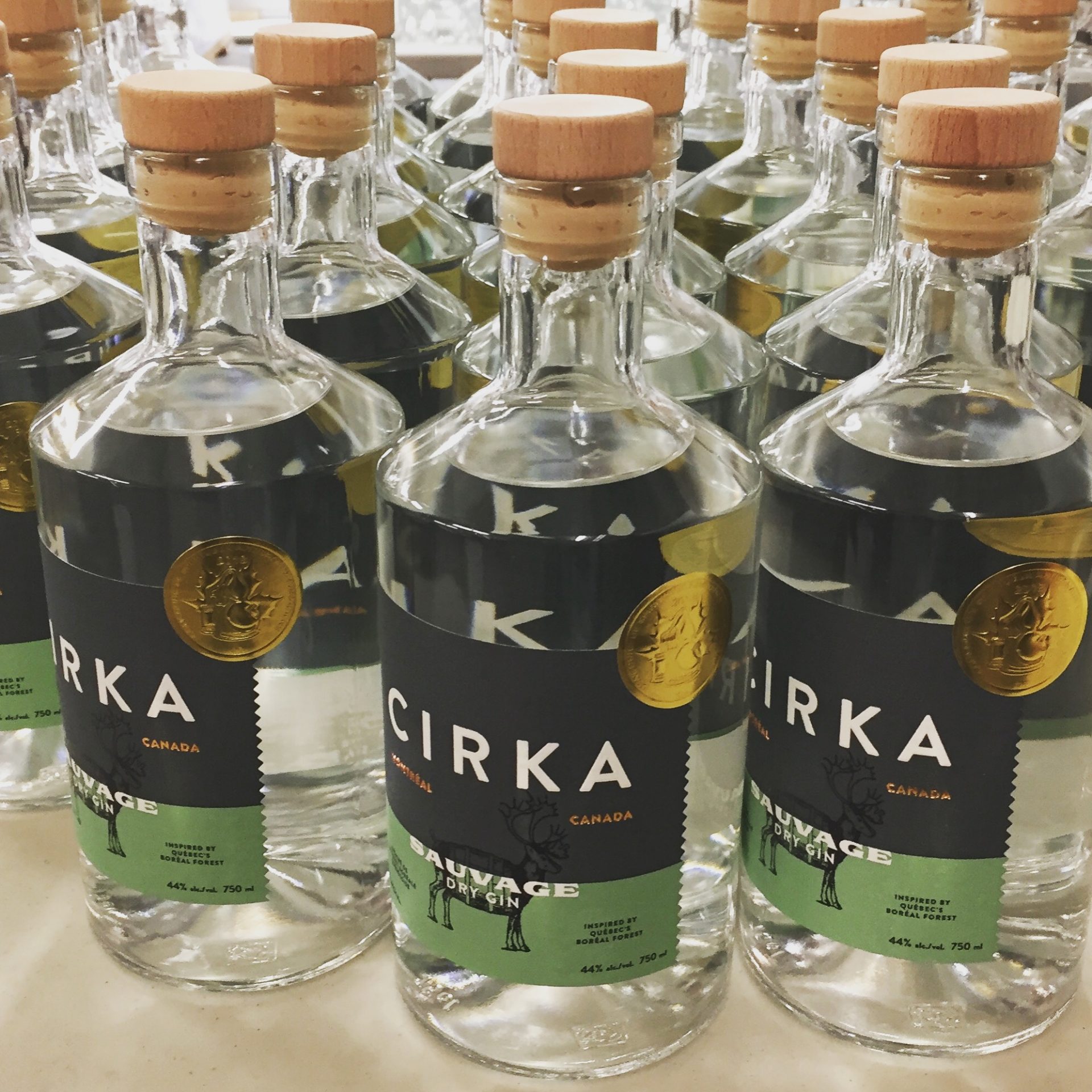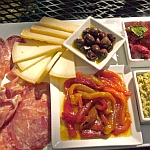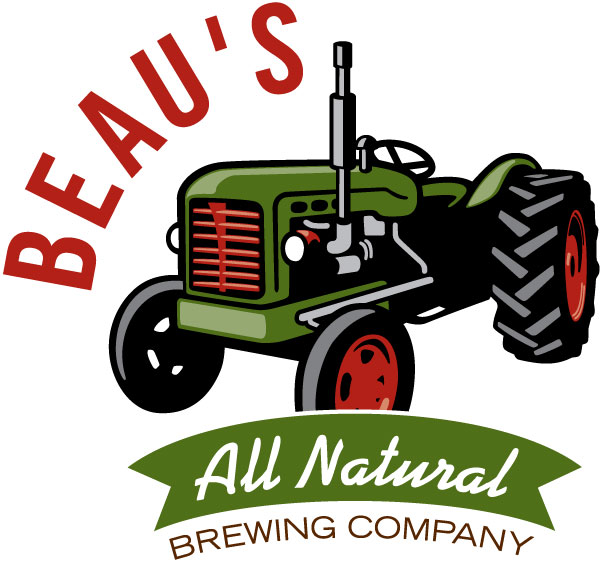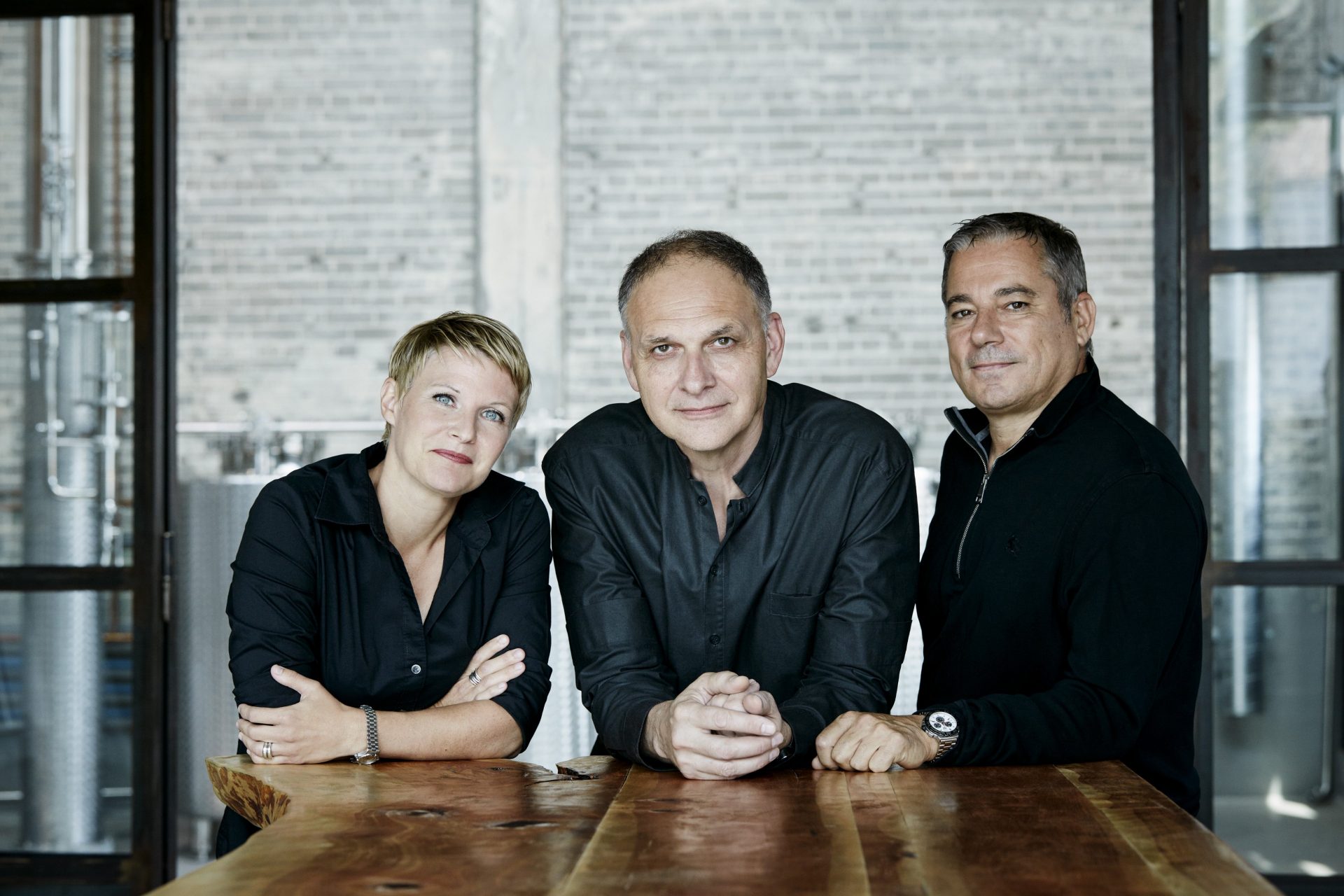
The good folks at Cirka (L-R) : JoAnne Gaudreau, Partner, Co-founder and VP Marketing , Paul Cirka, Partner, Co-founder, President & Master Distiller, and John Frare, Partner, Co-founder, Director of Operations.
Having been partial to the ambrosial delights of Montreal-based distillers Cirka since I first tasted some samples of their spirits some months ago, I felt an urge to get to know a little more about this boutique operation and the three people behind the project.
Good Food Revolution: First off, let me say that I have a particular soft spot for your gins… they really are gorgeous. I appreciate the samples, as gin can often be my Achilles heel when it comes to spirits.
Now, let’s start at the beginning…
Your careers weren’t all originally in spirits were they? What brought you to the world of artisanal spirits from your previous careers?
JG: Both Paul Cirka (our master distiller and co-founder) and I worked in high tech for a long time when we both decided we wanted to move into another industry – toward something more tangible, more human – liquid pleasure! Paul started the business plan, and upon reading it, I was immediately drawn to the project. I left my full-time VP Marketing job at a tech company and jumped into the world of being an entrepreneur! My background is in marketing and communications so the basic principles are similar even if the industry is different.
GFR: Ahhhh… that makes a lot of sense just looking at all of your branding.
JG: We are three co-founders and partners. Paul Cirka is our president and master distiller, he oversees all production and the development of new products amongst many other part of the business. John Frare has a separate business and he led the construction of our facility and equipment installation. It took over a year to finalize the renovations and to get the equipment ready for production. The development of our products took us a while since were selecting suppliers, tasting raw materials etc… and we wanted to focus on using quality ingredients. Our goal was to create unique spirits so it took us some time to develop and to fine-tune the recipes.
GFR: So, did you drink a great deal of spirits before this project, or did you have to get up to speed rapidly?
PC: I have always been more of a spirits drinker, whisky in particular, and I would often enjoy a whisky with my father-in-law – our first whisky barrel was named in honour of him. Whisky production is the reason we started the project in the first place. Additionally, being an amateur cook coupled with my botany background, I was intrigued by the idea of making gins using different flavours. We have an amazing terroir in Québec for the production of spirits, from high quality grains like corn, rye and barley to unique botanicals from our Northern forests.
JG: We all enjoyed a good cocktail or two for sure! I have always liked gin and started getting into whisky when the project was initiated. We certainly taste our products regularly but we also rely on feedback from other sources (like mixologists) when developing new products. We have to be proud of the products we produce and we’re a tough crowd!
GFR: And from where did you get your inspiration? I guess I’m asking who you think does a great job, both here in Canada and elsewhere around the globe?
Gin, vodka, and whisky?
PC: …
Vodka: There is certainly a difference between industrial and craft vodkas. There are beautiful craft vodkas, some of which are made of winter wheat, some made of apples (Ironworks). Our goal was to create a unique profile and a smooth finish with our vodka – it’s also the first grain to bottle vodka produced in Québec.
Gin: We look for complexity in balance in most of the gins we enjoy. You can get quite creative with gin. That being said, a good gin should make great cocktails and it should work well in classics like Martinis, Negronis and Gin & Tonics. That was the test for our Gin Sauvage which is a contemporary London Dry. Hendricks certainly redefined the traditional gin flavour profile with something new and contemporary. There so many great gins to choose from now – it really depends on your mood and how you want to consume the product. Sipping gins are also becoming a new way to consume the product, it’s the premise behind our Limited Edition GIN375.
Whisky: We enjoy different whisky styles from different parts of the world: Bourbon, Rye, Single Malts. There is a wide variety of whisky styles and flavours providing an incredible array of palates that come from using different grains, different climates conditions, type of yeasts being used, woods used for aging, etc…
We are all huge fans of Japanese whiskys. They are influenced by traditional Scottish techniques but they have married their terroir (ie. wood) to create something unique in style. It’s like Zen and the Art of Whisky Making. Attention to detail matters to the end result and we share a similar philosophy.
GFR: Please tell us about your two gins, and the thinking behind them… what is it that makes them so very different from anything else in our market right now? And they certainly are different!
PC: We are fortunate enough to live in close proximity to some beautiful forests in Québec, which are very rich in beautiful botanicals. Additionally, we also have a wide array of berries, honeys and other raw materials like grains (corn, barley, rye). Our goal is to express the best of Québec’s terroir in our spirits.
Our Gin Sauvage is a contemporary London Dry Gin and it is really an expression of Québec’s Boréal forest. We wanted to bottle the feeling, the smell, the emotion that arises from a walk in an old growth forest – think about how a forest smells, looks and feels after it has rained and the sun starts to shine – that is truly a magical time in forest. We use more than 30+ botanicals in our Gin Sauvage so it quite complex and something new will rise to the top with every sip. Our goal was to make a gin for gin lovers. We like to describe it as a conversion gin since the product has managed to convert non-gin drinkers in gin lovers.
Our GIN375 is a contemporary version of an Old Tom-style gin and it was inspired by Montréal’s 375th anniversary (the product was first released in 2017). We intended to pay homage to our city and our province by creating a product that captured the best of what our terroir has to offer. As such, we used cranberry and sour cherry from the Eastern Townships – these fruits were used to flavour and colour the gin. We also used rose petals and wild mint from the Gaspé region and organic Spring honey from the Laurentians. We wanted to create a gin you could enjoy neat like you would a fine whisky.
GFR: And do you personally like to enjoy these two gins? I’m a bit of an old Scottish fart and enjoy an old fashioned gin and tonic… with lemon. The lemon is very important for me!
JG: We love both but it depends on what we feel like drinking. I tend to lean toward the Gin Sauvage since I am both a Gin & Tonic and a Negroni lover (and Paul loves his Hanky Panky!). Like any good cocktail, you need the right ingredients. To make a proper Gin & Tonic, you need a good tonic that complements the gin you’re drinking. In a Negroni, you need a gin that stands up against the Campari and Vermouth.
PC: The citrus element is important in any cocktail. In our Gin Sauvage, we chose Bergamot instead of lemon but when you add lemon to it, there is a nice highlight.
We did not use a strong citrus base in our GIN375 since we wanted to focus on what is available in Québec. However, we used botanicals that would complement citrus so we used larch because larch tips have a hint of lemon.
You can create some very funky gins that don’t well in cocktails but it was important that both of our gins work well in cocktails. Although things are starting to change, most people still don’t drink gin neat.
GFR: Now, I’m no snob when it comes to my tonic water, but you were mentioning that you have done some experimentation. So what’s the verdict?
PC: The tonic in a Gin & Tonic is extremely important – it can make up ½ or ¾ of your cocktail depending on your preferred ratio. The tonic needs to complement the gin. The wrong gin and tonic combination can ruin your cocktail. We are big fans of Fever Tree tonics since they are not as sweet and they complement our gin very well. There are many great specialty tonics but they have to work well with the gin you choose. It’s fun to try different tonics and the effects it will have on your cocktail.
GFR: I know that your products were especially well-received at the recent Made With Love cocktail competition. Can you tell me a little more about that? I believe that your gins were used in the winning drinks?
JG: Actually, our Vodka Terroir was used in the Made With Love competition in Ottawa and Toronto and we are delighted that both winners of the mixology competition used our vodka. Eric Romolock won the public’s choice in Ottawa and Axl Gonzalez won the judge’s choice in Toronto. We were honoured to have our vodka selected by them in the first place and absolutely delighted about their respective wins!
GFR: So the cocktail/mixology community has obviously embraced your products! How have you found the differences in those communities betwixt Montreal and Toronto, and elsewhere for that matter? Is there one product that does particularly well in one city and less so in another? I’m always curious about different provinces having different palates?
JG: Our market entry started by targeting mixologists first and consumers later. We always like to get feedback on our products. We appreciate their palates, their creativity, and their transformation of a spirit into a gorgeous cocktail. Every city is quite different. In general, mixologists appreciate variety and unique products no matter where they come from. I believe Québec has developed a stronger taste for craft gins in the last 3 years and there is much larger variety available in Québec right now than there is in Ontario. It’s hard to define the specific differences at this time since we are just getting started in the Ontario market. Ask us again in about 6 months!
GFR: Gin is still one of the hottest things ever in Europe… but we are always a little behind in such things. Do you feel that the time has arrived for ultra-premium artisanal spirits in the mainstream within Canada? What challenges do you face presenting your product to the general public at such a premium price point?
PC: Consumers have a growing appreciation for craft spirits – this is a worldwide trend. We don’t have as many bars fully dedicated to gin in Canada the way they do in Spain but we have seen a growing curiosity and appetite for gin in the last 3 years. A gin renaissance if you will. The west coast is far ahead when it comes to craft production but the east coast is catching up.
Craft spirits tend to be more expensive in general. Craft distillers don’t have the same volumes that can bring down the price as do the bigger brands. Additionally, when you’re using quality ingredients to produce the product, you need to cover your production costs in the pricing. We produce all of our products from grain to bottle using non-GMO corn and high quality grains. We also use real botanicals, some of which are unique and they can be quite expensive since availability tends to be seasonal and in smaller volumes. You could say we are targeting people who appreciate quality over quantity.
GFR: Now your vodka is pretty cool too… Vodka Terroir.
Would you mind explaining this concept, and the story behind the issues you faced when you first brought it to market in Quebec?
JG: We’re proud to be the first grain to bottle craft vodka made in Québec (we won an innovation award). Although our story has a happy ending, our initial launch in Québec was quite challenging. The day before our very first order was to get picked up, we were told our vodka had too much character to be considered a vodka – seems it was not as neutral as an industrial vodka. After a few weeks of tests and much deliberation, we chose to stay true to our original flavour profile and our product was labelled a ‘grain-based spirit’ for a while. We eventually won our vodka designation back but it’s an example of how craft can deviate from more industrial products.
GFR: I find the whole tale most fascinating, as it runs in parallel to some of the conversations we are having in the wine world about the VQA panel tasting for typicity. I think that for us to grow as an industry, both in wine and spirits (it appears that beer is the Wild West and it’s wonderful!), we need to encourage experimentation and innovation and let the market decide, rather than fiscally punishing (through taxation and labelling regulations) those who dare to try something different… Your thoughts?
PC: There are certain guidelines we need to respect to keep the designation intact but craft is about creativity and many craft distillers are trying to create unique profiles. As such, traditional categories are being pushed beyond, questioned and redefined. We might have to start lobbying for change of some of the definitions at the federal level. That being said, there is a significant amount of subjective interpretation of federal definitions that varies from province to province and provinces have the final say in product designations and how the definitions are interpreted and enforced.
We believe people should be able to use the raw materials that best express the terroir in which the product is produced – you can use potatoes, corn, rye, apples, to make a gorgeous vodka that provides a hint of its origin.
GFR: Like many a distiller, your goal is to eventually make aged whiskies. How long does that process take and how far along are you already? And it must take up a fair bit of space and capital, non? Hence the production of gin and vodka?
PC: Many craft distillers aspire to produce whisky but the aging process takes a minimum of 3 years for a Canadian whisky designation. Producing the whisky is not as long as aging, but aging is where the magic happens and that is indeed a game of patience which requires an investment in space and capital. Many craft distillers start by producing white spirits – they are shorter to produce and help support the whisky program. White spirits also help build the brand and prove you know how to make quality products. We spent as much time and love in our white spirits as we do with our whiskys. We developed our white spirits first and then moved into whisky production.
GFR: Now this may a dumb question, and maybe one for your master distiller/blender, but what kind of style of Whisky can we expect from CIRKA? How are your barrels of amber liquid tasting thus far?
PC: We are producing 3 different styles of whisky.
1) Rye: Canada is known for its Rye whisky so we create a 100% whisky, a true Canadian classic. More and more people are attracted to the complexity and spiciness of Rye. We are fortunate that rye grain is readily available in Québec.
2) Blend: Canada has a unique methodology: we cook our grains separately, using different yeasts that yield different flavours and then blend later in the process. We have added our own twist so we have our proprietary technique.
3) Single Malt: In our mind, this is the Holy Grail of whisky making. Grain selection is very important and the drying of your grains is very important to the end result.
Our oldest barrel is getting close to the 24-month mark. We will be using a combination of new and used barrels to develop flavours. We monitor progress monthly. The colour is gorgeous and we are very pleased with the progress. We have created a special tasting group to get ongoing feedback on the development of our whiskys.
GFR: It looks like you have a lovely little facility up there in Montreal. Is it currently open to the public?
JG: We are located in an industrial part of Montréal but we are close to the Lachine Canal, Griffintown and Old Montréal. Our distillery is open to the public for tours (by appointment) and we also host mixology classes and private events. We believe CIRKA should be an experience, not just another spirit. We enjoy talking about how we make our products and the connection with our consumers is really important to us. We hope you can visit us this summer Jamie!
GFR: And if people cannot make the trip, which of your products are currently available in Ontario, and where? (LCBO, bars, private order)
JG: We have two products available at the LCBO as of June 2018. Our CIRKA Vodka Terroir is available at select LCBO stores and our CIRKA Gin Sauvage is available as an online exclusive on www.lcbo.com Our first order of vodka will include a sample of our gin so people can get a chance to taste both of our products. Look for our tasting events this Spring & Summer – you can find out more by following our Facebook page or Instagram account.
GFR: So, whisky aside, what is next for CIRKA? I’m guessing that as your markets grow you’ll need to increase the size of production?
PC: We have started selling our white spirits in Alberta and Nova Scotia as well so we want to continue to grow within Canada. We are also exploring exportation to international markets. As our markets expand and grow, our production will certainly have to scale accordingly but we’re being very selective about which markets we want to explore right now.
GFR: Thanks so much for your time, JoAnne. Hopefully I’ll have the opportunity to come and visit you up there in Montreal soon!
Consider this a personal invitation to visit our distillery Jamie, thanks for your interest and we hope to see you in Montréal this summer. Hopefully, the snow should have melted by July!
GFR: I’ll look forward to that very much! Haha… yes… that snow.
Look out for reviews of Cirka’s excellent spirits over the coming weeks.
Cirka are represented in Ontario by Hobbs & Co.
Hobbes & Co. are a Good Food Fighter. Please support the businesses and organizations that support Good Food Revolution.

Edinburgh-born/Toronto-based Sommelier, consultant, writer, judge, and educator Jamie Drummond is the Director of Programs/Editor of Good Food Revolution… And those beers were showing extremely well.

Edinburgh-born/Toronto-based Sommelier, consultant, writer, judge, and educator Jamie Drummond is the Director of Programs/Editor of Good Food Revolution… And he’s booking that trip to Montreal soon.


